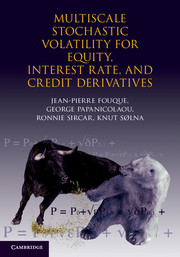Book contents
- Frontmatter
- Contents
- Introduction
- 1 The Black–Scholes Theory of Derivative Pricing
- 2 Introduction to Stochastic Volatility Models
- 3 Volatility Time Scales
- 4 First-Order Perturbation Theory
- 5 Implied Volatility Formulas and Calibration
- 6 Application to Exotic Derivatives
- 7 Application to American Derivatives
- 8 Hedging Strategies
- 9 Extensions
- 10 Around the Heston Model
- 11 Other Applications
- 12 Interest Rate Models
- 13 Credit Risk I: Structural Models with Stochastic Volatility
- 14 Credit Risk II: Multiscale Intensity-Based Models
- 15 Epilogue
- References
- Index
2 - Introduction to Stochastic Volatility Models
Published online by Cambridge University Press: 07 October 2011
- Frontmatter
- Contents
- Introduction
- 1 The Black–Scholes Theory of Derivative Pricing
- 2 Introduction to Stochastic Volatility Models
- 3 Volatility Time Scales
- 4 First-Order Perturbation Theory
- 5 Implied Volatility Formulas and Calibration
- 6 Application to Exotic Derivatives
- 7 Application to American Derivatives
- 8 Hedging Strategies
- 9 Extensions
- 10 Around the Heston Model
- 11 Other Applications
- 12 Interest Rate Models
- 13 Credit Risk I: Structural Models with Stochastic Volatility
- 14 Credit Risk II: Multiscale Intensity-Based Models
- 15 Epilogue
- References
- Index
Summary
The Black–Scholes model makes a number of simplifying assumptions. Among these are that the asset price has independent Gaussian returns and constant volatility. We shall focus here on relaxation of these assumptions by allowing volatility to be randomly varying, for the following reason: a well-known discrepancy between Black–Scholes-predicted European option prices and market-traded options prices, the implied volatility skew, can be accounted for by stochastic volatility models. That is, this modification of the Black–Scholes theory has a posteriori success in one area where the classical model fails.
In fact, modeling volatility as a stochastic process is motivated a priori by empirical studies of stock price returns in which estimated volatility is observed to exhibit “random” characteristics. As we will see, stochastic volatility has the effect of thickening the tails of returns distributions compared with the normal distribution, and therefore modeling more extreme stock price movements. Stochastic volatility modeling is a powerful modification of the Black–Scholes model that describes a much more complex market.
In Chapter 1, we introduced the notation and tools for pricing and hedging derivative securities under a constant volatility lognormal model (1.2). This is the simplest continuous-time example of pricing in a complete market, while pricing in a market with stochastic volatility is an incomplete markets problem, a distinction we shall explain further below, and one which has far-reaching consequences, particularly for the hedging problem and the problem of parameter estimation.
Information
- Type
- Chapter
- Information
- Publisher: Cambridge University PressPrint publication year: 2011
Accessibility standard: Unknown
Why this information is here
This section outlines the accessibility features of this content - including support for screen readers, full keyboard navigation and high-contrast display options. This may not be relevant for you.Accessibility Information
- 62
- Cited by
